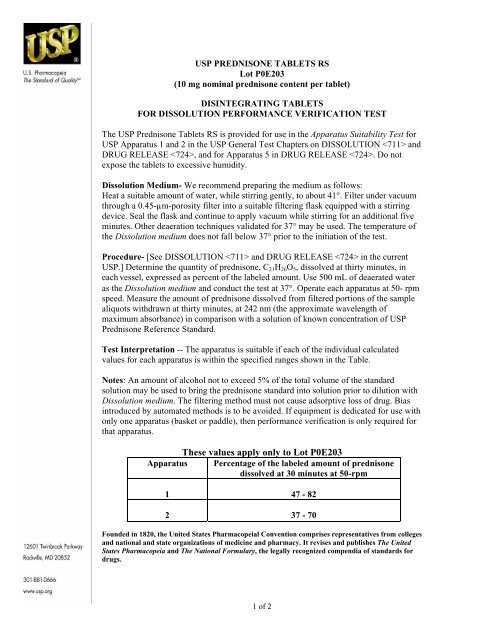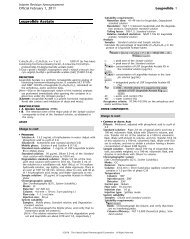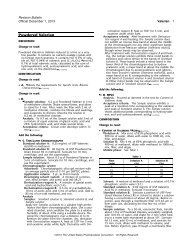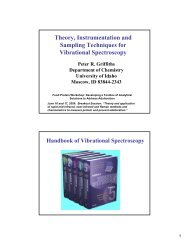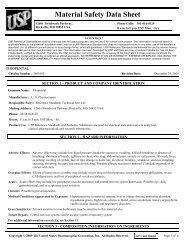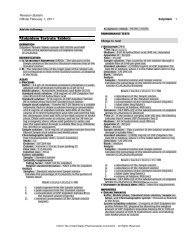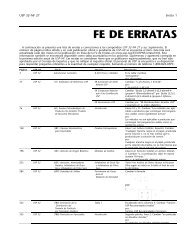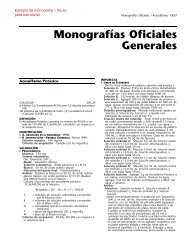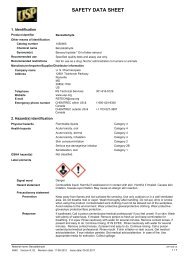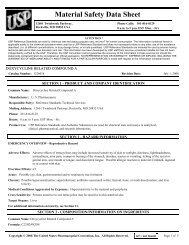USP Prednisone Tablets RS Lot P0E203 - US Pharmacopeial ...
USP Prednisone Tablets RS Lot P0E203 - US Pharmacopeial ...
USP Prednisone Tablets RS Lot P0E203 - US Pharmacopeial ...
Create successful ePaper yourself
Turn your PDF publications into a flip-book with our unique Google optimized e-Paper software.
<strong><strong>US</strong>P</strong> PREDNISONE TABLETS <strong>RS</strong><br />
<strong>Lot</strong> <strong>P0E203</strong><br />
(10 mg nominal prednisone content per tablet)<br />
DISINTEGRATING TABLETS<br />
FOR DISSOLUTION PERFORMANCE VERIFICATION TEST<br />
The <strong><strong>US</strong>P</strong> <strong>Prednisone</strong> <strong>Tablets</strong> <strong>RS</strong> is provided for use in the Apparatus Suitability Test for<br />
<strong><strong>US</strong>P</strong> Apparatus 1 and 2 in the <strong><strong>US</strong>P</strong> General Test Chapters on DISSOLUTION and<br />
DRUG RELEASE , and for Apparatus 5 in DRUG RELEASE . Do not<br />
expose the tablets to excessive humidity.<br />
Dissolution Medium- We recommend preparing the medium as follows:<br />
Heat a suitable amount of water, while stirring gently, to about 41°. Filter under vacuum<br />
through a 0.45-µm-porosity filter into a suitable filtering flask equipped with a stirring<br />
device. Seal the flask and continue to apply vacuum while stirring for an additional five<br />
minutes. Other deaeration techniques validated for 37° may be used. The temperature of<br />
the Dissolution medium does not fall below 37° prior to the initiation of the test.<br />
Procedure- [See DISSOLUTION and DRUG RELEASE in the current<br />
<strong><strong>US</strong>P</strong>.] Determine the quantity of prednisone, C21H26O5, dissolved at thirty minutes, in<br />
each vessel, expressed as percent of the labeled amount. Use 500 mL of deaerated water<br />
as the Dissolution medium and conduct the test at 37°. Operate each apparatus at 50- rpm<br />
speed. Measure the amount of prednisone dissolved from filtered portions of the sample<br />
aliquots withdrawn at thirty minutes, at 242 nm (the approximate wavelength of<br />
maximum absorbance) in comparison with a solution of known concentration of <strong><strong>US</strong>P</strong><br />
<strong>Prednisone</strong> Reference Standard.<br />
Test Interpretation -- The apparatus is suitable if each of the individual calculated<br />
values for each apparatus is within the specified ranges shown in the Table.<br />
Notes: An amount of alcohol not to exceed 5% of the total volume of the standard<br />
solution may be used to bring the prednisone standard into solution prior to dilution with<br />
Dissolution medium. The filtering method must not cause adsorptive loss of drug. Bias<br />
introduced by automated methods is to be avoided. If equipment is dedicated for use with<br />
only one apparatus (basket or paddle), then performance verification is only required for<br />
that apparatus.<br />
These values apply only to <strong>Lot</strong> <strong>P0E203</strong><br />
Apparatus Percentage of the labeled amount of prednisone<br />
dissolved at 30 minutes at 50-rpm<br />
1<br />
2<br />
47 - 82<br />
37 - 70<br />
Founded in 1820, the United States <strong>Pharmacopeial</strong> Convention comprises representatives from colleges<br />
and national and state organizations of medicine and pharmacy. It revises and publishes The United<br />
States Pharmacopeia and The National Formulary, the legally recognized compendia of standards for<br />
drugs.<br />
1 of 2
<strong>Prednisone</strong> <strong>Tablets</strong>: Performance Verification Notes<br />
Dissolution equipment that has been routinely used for a number of years (three-five) should be<br />
serviced if out-of-range values are obtained. The performance of any dissolution equipment that is<br />
used routinely should be verified at regular intervals. Relocation of apparatus always requires<br />
recertification. Some <strong><strong>US</strong>P</strong> Dissolution tests require 2-L vessels or speeds other than 50 and 100<br />
rpm. The equipment is suitable for these other conditions if it passes the performance verification<br />
tests.<br />
Examples for Sources of Error in Performance Verification Testing<br />
Deaeration of medium. Improper deaeration is a common problem. This formulation has<br />
been demonstrated to be sensitive to dissolved gases in the medium. One method of deaeration<br />
is as follows: Heat the medium, while stirring gently, to about 41º, and filter under vacuum<br />
through a 0.45-µm-porosity filter into a suitable filtering flask, equipped with a stirring device.<br />
Seal the flask and continue to apply vacuum while stirring for an additional five minutes. Do not<br />
allow the temperature of the Dissolution Medium to fall below 37° prior to the initiation of the<br />
test. Gently transfer the medium directly to the vessel. Rotating the Apparatus 2 shafts to speed<br />
equilibration to 37° is discouraged. Use medium promptly after it is equilibrated.<br />
Vessels. Vessels must be clean. Use of an unacceptable vessel is a systematic error.<br />
Vibration and mechanical problems. When not properly examined and maintained, factors such<br />
as dissolution head coplanarity, shaft perpendicularity, tension on the drive chain or belt,<br />
centering, and operating condition of the gear plates can adversely affect dissolution. Digital rpm<br />
readings may not necessarily represent individual spindle speeds. Visual inspection may be needed<br />
to observe surging of the separate spindles. To minimize vibration effects, the dissolution<br />
equipment should be on a stable bench top or table. Other mechanical equipment using fans,<br />
pumps, or other vibration sources should be removed from the area or isolated in some other way.<br />
Turbulence in the water bath caused by circulation patterns can affect results in one or more<br />
vessels.<br />
Automation. Always validate the automated method, including the analytical method and<br />
sampling method, by performing a parallel manual analysis, withdrawing test samples at the same<br />
times, and comparing to the automated results. Filter probes may become clogged, absorb the<br />
active ingredient, or generate additional turbulence through the air-purging step. Be alert to the<br />
possibility of carryover among samplings. Automated systems may not account for dilution and<br />
the absorbance reading may be over 1.0 absorbance units. Linearity above 1.0 absorbance should<br />
be established with a standard curve.<br />
<strong>Tablets</strong>. The <strong>Prednisone</strong> <strong>Tablets</strong> should be stored in the original containers in a dry place. Avoid<br />
excess humidity. When testing, take the tablets from the bottle and begin the dissolution test<br />
immediately.<br />
Reference Standard. Use the current lot of <strong><strong>US</strong>P</strong> Reference Standard and follow any handling<br />
instructions on the label. Prepare the standard solution on the day of use.<br />
Filtering. Do not centrifuge sample. The sample aliquot should be filtered immediately after the<br />
sample is drawn. The filters should be tested for interference from leachables or by adsorption of<br />
the drug. A separate clean syringe and filter should be used for sampling each vessel.<br />
Paddles and baskets. The shafts of both apparatuses should be straight. A simple test of this is to<br />
roll the shaft on the bench top with the paddle blade or prongs for the basket hanging over the<br />
edge. The shaft should roll evenly like an arrow shaft. Baskets should be straight and not frayed.<br />
Routine use in hydrochloric acid Medium causes deterioration of the stainless steel baskets.<br />
Baskets should attach firmly to the shaft prongs. Evaporation lids should be used. Inspect them<br />
for fit or warping.<br />
For additional information, see www.usp.org.<br />
2 of 2


